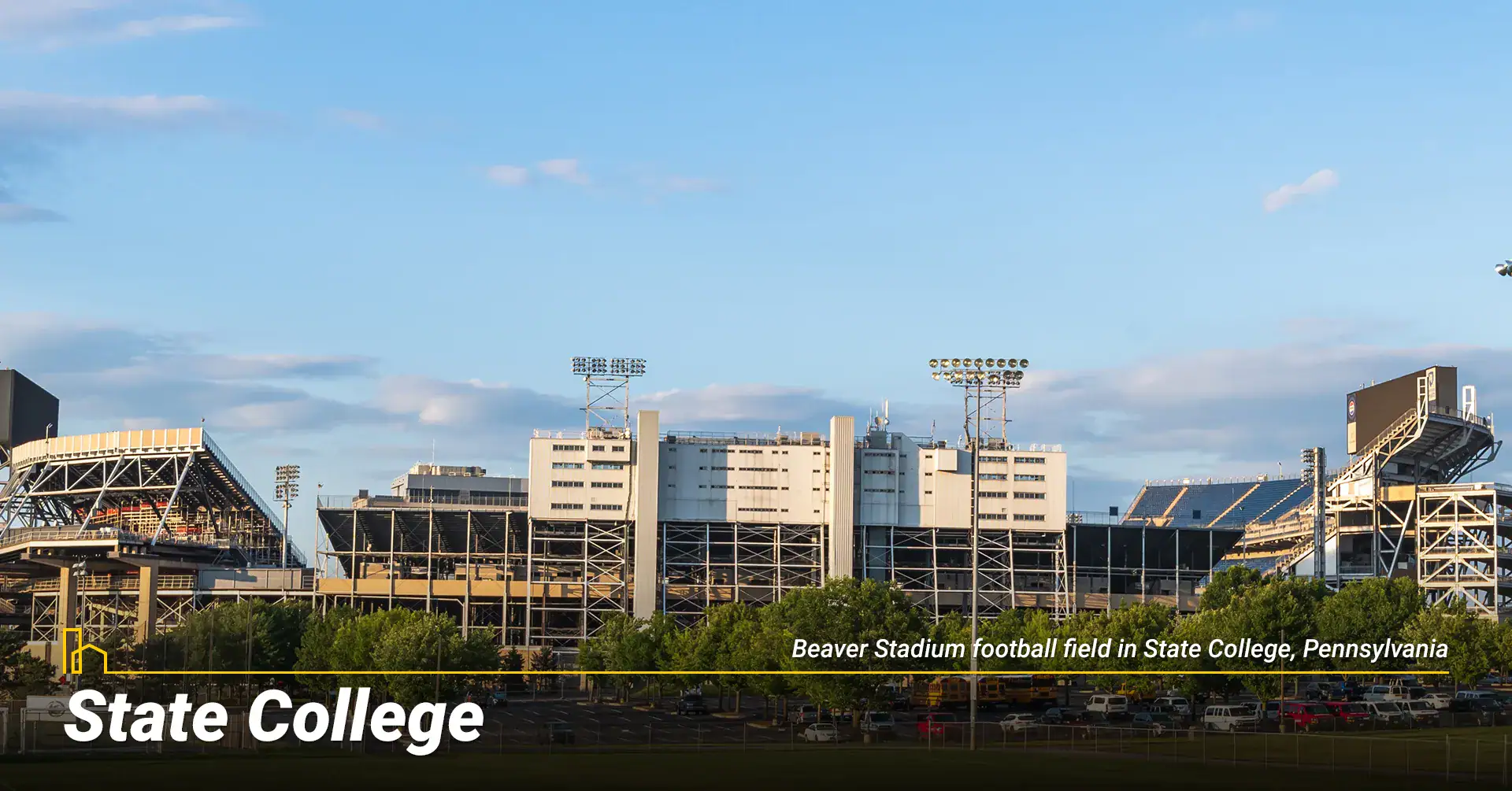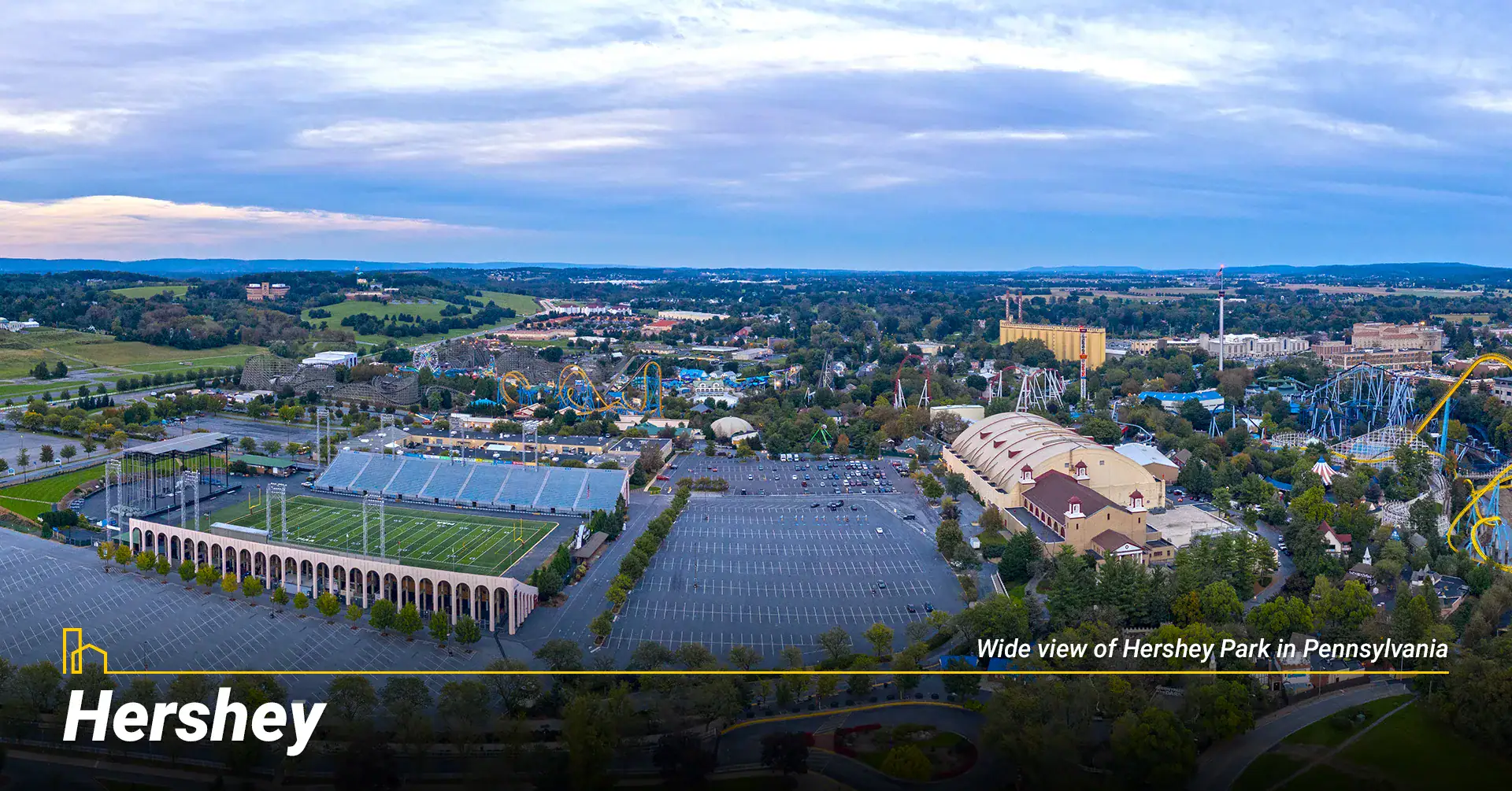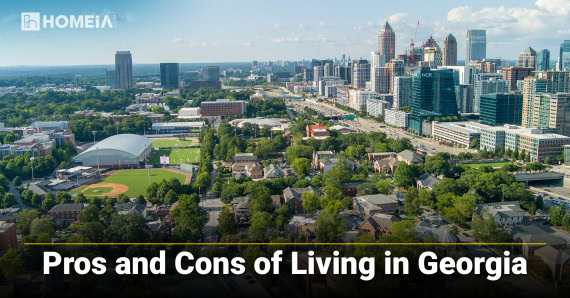The Pros and Cons of Living in Pennsylvania
- Local Editor:Local Editor: Katherine DeCosmo
Published: Jul 26, 2025
- Category: City Living Guide

When considering the best places to live in Pennsylvania, you might think of the iconic Liberty Bell in Philadelphia, the rolling farmland of Lancaster County, autumn hikes in the Poconos, or the energy of a Steelers game in Pittsburgh. All of these are important pieces in Pennsylvania’s identity, but there is much more to discover when moving to Pennsylvania.
If you’re researching Pennsylvania living costs and quality of life, you’ll find a state known for its rich history, scenic natural beauty, and affordable cost of living. However, Pennsylvania also has challenges like cold winters, variable tax rates, and economic disparities between regions.
This comprehensive Pennsylvania guide examines both the advantages and disadvantages of living in Pennsylvania with updated data and insights. We’ll also highlight the best Pennsylvania cities for young professionals, families, and retirees to help you determine if the Keystone State aligns with your lifestyle and budget.
11 Best Places to Live in Pennsylvania in 2025
Pennsylvania has it all: caves, mountains, waterfalls, culture and history. It is the 33rd-largest state by area and the fifth-largest by population. There are a lot of great places to live in the state. Below, you will find descriptions of 11 of them…
Table of Contents:
- Pros: Why Choose Pennsylvania? Top Benefits of Pennsylvania Living
- A. Affordable Cost of Living and Housing Market
- B. Rich History and Cultural Heritage
- C. Four Distinct Seasons and Natural Beauty
- D. Diverse Economy and Job Market
- E. Quality Healthcare and Education Systems
- F. Family-Friendly Communities and Civic Spirit
- G. Convenient Location and Transportation Access
- H. Vibrant Food, Arts, and Recreation Scene
- Cons: Pennsylvania Living Challenges You Should Know
- A. Cold Winters and Variable Weather Patterns
- B. Variable Property Taxes and Tax Considerations
- C. Economic Disparities and Infrastructure Challenges
- D. Limited Diversity in Certain Regions
- E. Rural Healthcare Access Issues
- F. Traditional Culture and Slower Change
- G. Job Market Challenges in Traditional Industries
- Best Pennsylvania Cities for Young Professionals
- Best Pennsylvania Communities for Families with Young Children
- Best Places to Retire in Pennsylvania
- Pennsylvania Lifestyle: Arts, Food, and Recreation
- Conclusion: Is Pennsylvania Right for Your Lifestyle?
- Frequently Asked Questions About Living in Pennsylvania
Pros: Why Choose Pennsylvania? Top Benefits of Pennsylvania Living

A. Affordable Cost of Living and Housing Market
Pennsylvania’s cost of living remains below the national average, especially compared to neighboring states like New York and New Jersey. The median home price statewide is approximately $240,000, with even lower prices in cities like Pittsburgh and Scranton.
Pennsylvania housing costs benefit renters with moderate prices, while everyday expenses like groceries and utilities remain manageable for most residents. A fun fact is that, generally, grocery items are tax exempt.
This affordability makes Pennsylvania a great fit for families, first-time homebuyers, and retirees seeking affordable places to live.
B. Rich History and Cultural Heritage
Pennsylvania is oozing with American history, such as Independence Hall, the Liberty Bell, Gettysburg Battlefield, and over 150 national historic landmarks.
Cities like Philadelphia and Pittsburgh have world-class museums, theaters, and music venues. The state’s diverse communities from Pennsylvania Dutch country to vibrant urban neighborhoods bring an exciting blend of traditions, festivals, and culinary experiences.
C. Four Distinct Seasons and Natural Beauty
Residents enjoy all four seasons: snowy winters, blossoming springs, warm summers, and colorful autumns. Pennsylvania outdoor activities include exploring the Appalachian Mountains, over 120 state parks, and countless lakes and rivers, such as one of the Great Lakes, Lake Erie.
Popular recreational opportunities include hiking, fishing, kayaking, skiing, and camping, all set against Pennsylvania’s scenic backdrops.
D. Diverse Economy and Job Market
Pennsylvania’s job market features a broad-based economy with strengths in healthcare, education, manufacturing, and technology. Major employers include health systems, universities, and Fortune 500 companies.
Pennsylvania unemployment rates typically hover at or below the national average, especially in metropolitan areas. The state’s expanding tech industry, particularly in Pittsburgh, attracts professionals in robotics, artificial intelligence, and biosciences.
Important Things to Consider Before Hiring a Moving Company
Whether you’re moving from state to state or just across town, hiring the right moving company will make a world of difference. So, before you hire just anyone, here are a few things that you should definitely consider…
E. Quality Healthcare and Education Systems
Pennsylvania has top-ranked hospitals, including the University of Pennsylvania Health System and UPMC. Renowned universities such as Penn State, University of Pennsylvania, and Carnegie Mellon are located throughout the state.
When it comes to the state’s education, many suburban and small-town school districts earn high ratings, making Pennsylvania an excellent choice for families prioritizing quality education.
F. Family-Friendly Communities and Civic Spirit
Many Pennsylvania towns and suburbs are known for safety, excellent schools, and family-oriented amenities. Community events, local festivals, and volunteer opportunities maintain strong neighborhood connections. If you are a newcomer, you will be impressed by Pennsylvanians’ authenticity and willingness to help.
G. Convenient Location and Transportation Access
Pennsylvania’s convenient location gives residents easy access to major East Coast cities, including New York, Washington D.C., and Baltimore. Residents also benefit from Amtrak services, major highways, and several international airports.
H. Vibrant Food, Arts, and Recreation Scene
Pennsylvania food ranges from Philly cheesesteaks to Pennsylvania Dutch specialties. A fun fact is Philadelphia was included in the Michelin Guide, and Pittsburgh is nationally recognized for its delicious cuisine.
Arts festivals, farmers’ markets, and craft beer trails are popular statewide, while Pennsylvania outdoor recreation remains accessible year-round.
For High-End Relocations, Luxury Moving Companies Deliver
Luxury moving experts offer personalized service and innovative solutions for transporting anything that requires extra care. Here are a few of the features a high-end moving company may be able to offer…
Cons: Pennsylvania Living Challenges You Should Know

A. Cold Winters and Variable Weather Patterns
Pennsylvania winters can be harsh and snowy, especially in northern and western regions. This climate requires snow removal gear, upkeep of the sidewalks, and higher heating costs.
Summers can be humid, while spring brings unpredictable rainfall and high pollen counts affecting seasonal allergies. Though keep in mind that throughout the entire year, there can be flash floods and high volumes of rain.
B. Variable Property Taxes and Tax Considerations
Pennsylvania property taxes vary across counties. Some urban and suburban areas have higher rates that burden homeowners. Pennsylvania maintains a flat state income tax (3.07%) but also levies local earned income taxes and inheritance taxes. Along with that, the state’s gasoline tax ranks among the highest nationally.
C. Economic Disparities and Infrastructure Challenges
While cities and suburbs thrive, some rural areas face limited Pennsylvania job opportunities and population decline. Roads, bridges, and public transit systems in older cities need investment and maintenance. Rural broadband access and healthcare services can be limited in remote areas as well.
Another thing to keep in mind is the Pennsylvania roads are very expensive and have high toll rates. Locals will tell you how there is constant road construction as well, which can be especially frustrating when running errands.
D. Limited Diversity in Certain Regions
Urban areas like Philadelphia and Pittsburgh have diversity, but many rural and small-town communities remain less diverse. Approximately 78% of residents identify as white, with limited representation from other demographic groups outside metropolitan areas.
E. Rural Healthcare Access Issues
Urban residents enjoy access to premier medical facilities, but rural Pennsylvanians may face longer travel times and fewer healthcare options, which can create disparities in medical care accessibility.
F. Traditional Culture and Slower Change
Rural areas lean toward more conservative and traditional values, which may not appeal to all residents. Social change and cultural diversity develop more slowly outside major metropolitan areas.
G. Job Market Challenges in Traditional Industries
Traditional industries like coal and manufacturing have declined, leading to job losses in certain regions. Younger workers may need to relocate or retrain for positions in growing economic sectors.
Recommended for you
Best Pennsylvania Cities for Young Professionals
1. State College

HOMEiA Score: 76/100
- Cost of Living: 5% above U.S. national average
Median Home Price: $304,000
Highlights: Top-tier education, safe environment, youthful energy, family-friendly amenities
State College is in central Pennsylvania’s Happy Valley and is also home to Penn State University. The 2025 population exceeded 40,000, with the metropolitan area reaching over 230,000. The university drives the local economy, supporting tech startups, research initiatives, and a thriving arts and sports scene.
Downtown State College remains lively year-round, hosting major festivals, live music venues, and sporting events. The area’s neighborhoods have a perfect mix of student-friendly apartments and family homes, with excellent schools and parks for quality living for all ages.
2. Lancaster

HOMEiA Score: 77/100
- Cost of Living: 2% above U.S. national average
Median Home Price: $313,000
Highlights: Historic charm, low crime rates, excellent schools, central location
Lancaster stands out for its small-town warmth and urban sophistication. With a city population near 60,000 and a metropolitan area exceeding half a million, Lancaster’s historic downtown features art galleries, independent shops, and diverse restaurants to match its multicultural heritage.
The city is perfect for tourists and attracts nearly 10 million visitors annually for events, markets, and festivals. Lancaster’s economy benefits from healthcare, education, and a thriving creative sector, while its proactive approach to public safety and community engagement has earned recognition for livability and innovation.
15 Things People Usually Forget When Moving
Whether or not you decide to hire a professional moving company, this guide includes everything you need for completing your move. It’s always best to have this list handy so you can check off each task and know that you’re on top of everything…
3. Harrisburg

HOMEiA Score: 78/100
- Cost of Living: 4% below U.S. national average
Median Home Price: $250,000
Highlights: Affordable living, scenic riverfront, government and healthcare employment, walkable downtown
Harrisburg, Pennsylvania’s capital, functions as a government, healthcare, and logistics hub, which is perfect for anyone looking for new connections and employment opportunities.
In 2025, the population is approximately 50,000, and with this size, Harrisburg offers a compact, walkable downtown centered around the impressive State Capitol building and revitalized riverfront area.
When it comes to recreation, the city hosts the annual Pennsylvania Farm Show, the largest indoor agricultural event in the country. It also features a growing arts and food scene alongside countless nightlife activities.
Recent infrastructure investments and stable city budgets have improved public services without raising property taxes, while proximity to Hershey and access to major transportation networks make regional exploration convenient.
27 Questions to Ask When Hiring a Moving Company
Hiring a moving company can be pretty daunting. You’re entrusting strangers with all your precious belongings, and you want to make sure they’re adequately insured, experienced, and licensed. In this blog post, we’ll cover some essential questions to ask when hiring a moving company and help you avoid moving mishaps…
4. Philadelphia
HOMEiA Score: 79/100
- Cost of Living: 6% above U.S. national average
Median Home Price: $322,000
Highlights: Career opportunities, diverse neighborhoods, robust arts and culture scene
Philadelphia, America’s sixth-largest city, maintains its status as an exciting urban center with a 2025 population of 1.55 million. The city’s rich historical background matches its modern dynamism, featuring iconic sites like Independence Hall alongside a significant contemporary arts scene.
Philadelphia’s neighborhoods range from trendy Fishtown and Northern Liberties to family-friendly Mt. Airy.
Unemployment stands at 4.5%, and job growth is outpacing national averages, particularly in the healthcare, education, and technology sectors. As for the food, Philadelphia’s unique cuisine earns national recognition with diverse dining options and historic markets.
5. Pittsburgh
HOMEiA Score: 80/100
- Cost of Living: 8% below U.S. national average
Median Home Price: $224,000
Highlights: Technology hub, affordable housing, walkable neighborhoods, vibrant dining and arts scene
Pittsburgh is a city experiencing constant changes, blending its industrial background with a forward-thinking, technology-driven future.
As of 2025, the city’s population has grown above 303,000, with the broader metropolitan area reaching 2.4 million residents. The economy benefits from world-class universities like Carnegie Mellon and the University of Pittsburgh. As a result, it is a magnet for research, robotics, and healthcare talent.
Neighborhoods such as Lawrenceville and Shadyside attract young professionals with lively nightlife, arts venues, and diverse dining options. Major redevelopment projects in the Strip District create new mixed-use spaces and affordable housing opportunities.
And, of course, it is the home to the Pittsburgh Steelers.
Recommended for you
Best Pennsylvania Communities for Families with Young Children
Ranked by HOMEiA Score (lowest to highest)
1. Aspinwall
HOMEiA Score: 78/100
- Cost of Living: 5% above U.S. national average
Median Home Price: $330,000
Highlights: Walkable community, abundant parks, strong community spirit
Aspinwall is a charming, walkable borough located just eight miles from downtown Pittsburgh, and it’s renowned for its strong community spirit and unique housing options. The neighborhood benefits from the highly regarded Fox Chapel Area School District and features the 12-acre Allegheny RiverTrail Park. This park features walking trails, playgrounds, dog parks, fishing docks, and kayak rentals.
With a median household income of $119,875 and a diverse population, Aspinwall has a welcoming, safe environment for families.
2. Franklin Park
HOMEiA Score: 79/100
- Cost of Living: 8% above U.S. national average
Median Home Price: $420,000
Highlights: Safe environment, family-friendly atmosphere, excellent schools
Franklin Park, which is in Allegheny County’s North Hills, thrives as a community with approximately 15,300 residents and a median household income of $172,200. Families appreciate the highly-rated North Allegheny School District, low crime rates, and abundant parks and recreational amenities.
Blueberry Hill Park is a local favorite with its playgrounds, sports fields, and an activity center with a commercial kitchen and event space. Aside from Blueberry Hill, Franklin Park also has an active local government, plenty of community events, and volunteer opportunities.
10 Important Things You Should Prepare for Long-Distance Moving
Moving long distances can be exciting, like an adventure of a lifetime. There is nothing as interesting and energizing as trying out new things and having the opportunity for a fresh start. But let’s be honest: moving is more complex than getting into a car or a bus and leaving for a new place…
3. Mount Lebanon
HOMEiA Score: 80/100
- Cost of Living: 6% above U.S. national average
Median Home Price: $350,000
Highlights: Outstanding schools, extensive parks, family amenities
Mount Lebanon is a historic suburb southwest of Pittsburgh that earns recognition for its top-rated public schools, community spirit, and walkable neighborhoods. The township features 15 parks, an Olympic-size swimming pool, an ice rink, and one of the oldest public golf courses in western Pennsylvania. Residents enjoy various family-friendly events, from seasonal festivals to youth sports leagues, while the Mt. Lebanon School District consistently ranks among the state’s best.
Mount Lebanon is a great fit for families due to its civic engagement and easy access to Pittsburgh via light rail.
4. Devon
HOMEiA Score: 81/100
- Cost of Living: 15% above U.S. national average
Median Home Price: $650,000
Highlights: Highly ranked schools, quiet residential streets, strong community connections
Devon is a small, upscale suburb on Philadelphia’s prestigious Main Line, known for leafy neighborhoods, historic homes, and outstanding educational opportunities.
The area hosts the renowned Devon Horse Show, the largest outdoor equestrian competition in the United States, which draws families and visitors each spring.
Jenkins Arboretum and Devon Lanes bowling alley provide year-round recreation, while nearby shopping and dining options cater to all tastes.
With a median household income of $194,813 and 100% homeownership rate, Devon has a stable environment with proximity to SEPTA rail and major highways for easy commutes to Philly.
5. Chesterbrook
HOMEiA Score: 82/100
- Cost of Living: 12% above U.S. national average
Median Home Price: $540,000
Highlights: Top-rated schools, safe neighborhoods, walkability, abundant parks
Chesterbrook is in the heart of Main Line suburbs and consistently ranks among Pennsylvania’s best places to raise families. The community celebrates its award-winning Tredyffrin-Easttown School District, abundant green spaces, and extensive walking and biking trails connecting neighborhoods to Wilson Park and the historic Valley Forge National Park.
Chesterbrook is known for its quiet suburban lifestyle and easy access to major highways. It also features shopping at the famous King of Prussia Mall along with other local amenities.
With a median household income of $140,972 and 64% homeownership rate, Chesterbrook has a safe, highly educated, and diverse environment, making it ideal for families seeking comfort and opportunity.
15 Essential Steps for Moving to a New City
If you’re moving to a new city, though, the process is even more complicated. Without the ability to make a quick trip here and there, you’ll need a detailed plan to keep everything running smoothly. This guide to relocation will help you make a plan and check all the boxes so your move will be as painless as possible...Best Places to Retire in Pennsylvania
Ranked by HOMEiA Score (lowest to highest)
1. West Chester
HOMEiA Score: 78/100
- Cost of Living: 10% above U.S. national average
Median Home Price: $480,000
Highlights: Historic downtown, strong healthcare access, active senior programs
West Chester attracts retirees with its historic downtown, active arts scene, and excellent healthcare facilities. The upcoming Charter Senior Living of West Chester will have active senior living, assisted living, and memory care, with amenities including life-enrichment programs, exceptional dining, and innovative social activities.
Residents benefit from walkable streets, boutique shopping, and local restaurants, while the area’s proximity to Philadelphia and access to top medical centers give retirees high convenience.
With a calendar full of community events and a welcoming atmosphere, West Chester provides seniors with a lively, supportive environment for retirement enjoyment.
2. Hershey

HOMEiA Score: 79/100
- Cost of Living: 6% above U.S. national average
Median Home Price: $330,000
Highlights: Walkable layout, superior healthcare, cultural events
Hershey, famous for its chocolate heritage, is a popular retirement destination combining small-town charm with modern amenities. Country Meadows of Hershey has comprehensive senior living services, including independent living, personal care, and memory support within a campus featuring walking trails, a dog park, and a bocce court.
Residents also enjoy proximity to Penn State Health Milton S. Hershey Medical Center, which is perfect for retirees with health concerns.
The town’s walkable layout, cultural attractions, and year-round events like concerts and festivals provide retirees with a lively, connected lifestyle in a picturesque setting perfect for active aging.
An Ultimate Guide to Moving for Home Buyers and Sellers
Buying and selling a home doesn’t make you an expert in moving. Buying and selling are much more different when you’re actually moving. Carefully go through the tips listed below and uses these as your ultimate guide whenever moving…
3. State College

HOMEiA Score: 80/100
- Cost of Living: 5% above U.S. national average
Median Home Price: $304,000
Highlights: Safe environment, educated population, university amenities
State College is good for retirees seeking lifelong learning opportunities and campus energy. The Village at Penn State has university-based retirement living, granting residents access to Penn State classes, lectures, sporting events, and cultural performances.
The community features walking trails, modern amenities, and group activities, while the town maintains its reputation for safety, walkability, and a friendly atmosphere. Healthcare is readily available, and there are plenty of parks and recreation areas throughout the region.
State College’s energetic downtown with shops, cafes, and festivals makes it easy for retirees to stay active.
4. Pittsburgh
HOMEiA Score: 81/100
- Cost of Living: 8% below U.S. national average
Median Home Price: $224,000
Highlights: Affordable living, accessible healthcare, rich cultural offerings
Pittsburgh offers retirees an exceptional combination of affordability, culture, and healthcare access. The city hosts premier retirement communities like The Village at St. Barnabas, which has luxury condominium-style apartments, on-site healthcare, and amenities like a heated pool, mall, and fine dining.
Pittsburgh’s high-quality hospitals, including UPMC, have top-tier medical care for residents. Retirees can enjoy an active arts scene, professional sports, and scenic riverfront parks throughout the area.
The city’s diverse neighborhoods, robust public transportation system, and active senior programs ensure residents stay engaged and connected for worry-free retirement living.
5. Lancaster

HOMEiA Score: 82/100
- Cost of Living: 2% above U.S. national average
Median Home Price: $313,000
Highlights: Ranked #1 retirement destination, vibrant downtown, excellent healthcare access
Lancaster stands out as an exceptional retirement destination due to its small-city charm and convenient amenities for seniors.
The area has multiple award-winning 55+ communities, such as Willow Valley Communities and Calvary Homes, and these communities have independent living, assisted care, and resort-style amenities.
Retirees enjoy Lancaster’s energetic arts scene, farmers markets, and downtown’s walkable Market District with easy access to theaters, museums, and fine dining. The city also boasts excellent healthcare facilities and simple public transportation networks.
Lancaster’s friendly atmosphere, active faith-based communities, and scenic countryside make it ideal for fulfilling retirement living.
30 Best Packing Tips for Moving to a New City
How do you get everything safely from Point A to Point B on a tight schedule? With a lot of planning. Here are our best tips to make the process of moving to a new city as smooth as possible…
Pennsylvania Lifestyle: Arts, Food, and Recreation

A. Arts and Culture
Philadelphia and Pittsburgh anchor the state’s vibrant arts scene with world-renowned museums, theaters, and music venues. Annual events like the Central Pennsylvania Festival of the Arts and Art of the State in Harrisburg showcase local talent.
Most notably, Pennsylvania is a historic state with countless museums and landmarks, such as the Gettysburg National Military Park, available to the public.
B. Food Scene
Pennsylvania’s culinary identity includes cheesesteaks, soft pretzels, scrapple, shoofly pie, and an expanding selection of global cuisines. Beverage-wise, the state’s wineries and craft breweries continue gaining national recognition.
Anyone familiar with Pennsylvania also knows residents enjoy their pierogies and pizza, with there being many popular local pizza restaurants around the state.
C. Recreation and Outdoor Activities
State parks, rivers, and trails offer year-round activities including hiking, kayaking, fishing, skiing, and camping. Pennsylvania even has the slogan “Keep Pennsylvanian Beautiful,” showing how dedicated the state is to the conservation of the outdoor environments.
D. Festivals and Community Events
Countless events like the Bloomsburg Fair, the Stoudtburg Village, the Lehigh Valley Mall, holiday markets, and summer arts festivals bring neighbors together and foster local pride.
Whether you’re seeking great art, delicious food, or outdoor adventure, Pennsylvania’s lifestyle has something for everyone.
Conclusion: Is Pennsylvania Right for Your Lifestyle?
Pennsylvania has a diverse range of communities, including energetic urban centers, peaceful small towns, and scenic countryside escapes, which mesh well with varying lifestyles and preferences.
Whether your goals include career advancement in the city, raising a family in a safe community, or enjoying a relaxing retirement near nature, the Keystone State provides multiple options for every life stage.
Carefully evaluate Pennsylvania’s advantages and challenges against your personal priorities, budget, and lifestyle preferences to find your ideal home and community.
Recommended for you
Frequently Asked Questions About Living in Pennsylvania
1. What is the cost of living in Pennsylvania compared to other states?
Pennsylvania’s cost of living remains below the national average, especially for housing. Major cities offer more affordability than other East Coast metropolitan areas, while rural areas provide even lower costs.
2. How severe are Pennsylvania winters?
Pennsylvania winters can be cold and snowy, particularly in northern and western regions. Residents adapt with proper gear and by embracing winter sports and seasonal traditions.
3. Is Pennsylvania a good place for families to live?
Yes. Many Pennsylvania towns and suburbs have excellent schools, parks, and family-friendly amenities. However, school quality varies, so research local ratings before choosing a community.
4. What are the job prospects in Pennsylvania for 2025?
Pennsylvania’s job market remains strong in healthcare, education, and technology, with Pittsburgh and Philadelphia serving as major employment hubs.
5. How is healthcare access throughout Pennsylvania?
Urban areas have excellent healthcare facilities, while some rural areas have fewer options. Pennsylvania has several top-ranked hospitals and medical centers, like Penn Medicine in Philadelphia.
6. What are the best outdoor activities in Pennsylvania?
Pennsylvania outdoor recreation includes hiking, kayaking, fishing, skiing, and camping. State parks, such as Lackawanna State Park, and forests offer year-round opportunities for outdoor enthusiasts.
7. What should newcomers know about Pennsylvania taxes?
The state income tax is low at 3.07%, but property and local taxes vary significantly. Gasoline and inheritance taxes exceed the average rates, with the gasoline tax at 57.6 cents per gallon, and inheritance taxes vary depending on the beneficiary.
Retirees should carefully review tax implications for retirement income before moving to Pennsylvania.
Moving Container Value Guide: PODS, U-Pack and PACK-RAT
This comprehensive comparison of the three industry leaders—PODS, U-Pack, and 1-800-PACK-RAT — examines which company might best suit your specific moving and storage needs. We’ve analyzed pricing, container quality, availability, storage options, and customer experiences to help you make an informed decision…
Table of Contents:
- Pros: Why Choose Pennsylvania? Top Benefits of Pennsylvania Living
- A. Affordable Cost of Living and Housing Market
- B. Rich History and Cultural Heritage
- C. Four Distinct Seasons and Natural Beauty
- D. Diverse Economy and Job Market
- E. Quality Healthcare and Education Systems
- F. Family-Friendly Communities and Civic Spirit
- G. Convenient Location and Transportation Access
- H. Vibrant Food, Arts, and Recreation Scene
- Cons: Pennsylvania Living Challenges You Should Know
- A. Cold Winters and Variable Weather Patterns
- B. Variable Property Taxes and Tax Considerations
- C. Economic Disparities and Infrastructure Challenges
- D. Limited Diversity in Certain Regions
- E. Rural Healthcare Access Issues
- F. Traditional Culture and Slower Change
- G. Job Market Challenges in Traditional Industries
- Best Pennsylvania Cities for Young Professionals
- Best Pennsylvania Communities for Families with Young Children
- Best Places to Retire in Pennsylvania
- Pennsylvania Lifestyle: Arts, Food, and Recreation
- Conclusion: Is Pennsylvania Right for Your Lifestyle?
- Frequently Asked Questions About Living in Pennsylvania
Katherine DeCosmo is a Binghamton University graduate who has been writing online for nearly a decade. Her favorite genres include science fiction, fantasy, and thrillers. Along with writing as a hobby, Katherine is experienced with professional content writing and editing. She is from Wilkes-Barre, Pennsylvania, and she enjoys going to local concerts, taking walks along the Susquehanna River, and traveling to Hershey, which is her favorite place in Pennsylvania.
HOMEiA is a city guide site where visitors can find detailed information about communities of interest. HOMEiA’s City Guides, created in partnership with local writers and editors, are curated lists of the best, safest, and most affordable places to live. The guides feature the HOMEiA Score, a proprietary index that rates communities on such factors as housing costs, education, employment, etc.
HOMEiA.com aims to be the premier site for people planning to relocate, providing them with insightful content and connecting them with skilled real estate professionals.
We also empower real estate professionals to establish or strengthen their web presence by highlighting their experience, knowledge and achievements. If you’re selected to join our list of certified real estate professionals, you will distinguish yourself from your peers — and earn HOMEiA’s support.
If you believe in HOMEiA’s mission, please share our website with others.
Table of Contents:
- Pros: Why Choose Pennsylvania? Top Benefits of Pennsylvania Living
- A. Affordable Cost of Living and Housing Market
- B. Rich History and Cultural Heritage
- C. Four Distinct Seasons and Natural Beauty
- D. Diverse Economy and Job Market
- E. Quality Healthcare and Education Systems
- F. Family-Friendly Communities and Civic Spirit
- G. Convenient Location and Transportation Access
- H. Vibrant Food, Arts, and Recreation Scene
- Cons: Pennsylvania Living Challenges You Should Know
- A. Cold Winters and Variable Weather Patterns
- B. Variable Property Taxes and Tax Considerations
- C. Economic Disparities and Infrastructure Challenges
- D. Limited Diversity in Certain Regions
- E. Rural Healthcare Access Issues
- F. Traditional Culture and Slower Change
- G. Job Market Challenges in Traditional Industries
- Best Pennsylvania Cities for Young Professionals
- Best Pennsylvania Communities for Families with Young Children
- Best Places to Retire in Pennsylvania
- Pennsylvania Lifestyle: Arts, Food, and Recreation
- Conclusion: Is Pennsylvania Right for Your Lifestyle?
- Frequently Asked Questions About Living in Pennsylvania














































































































































